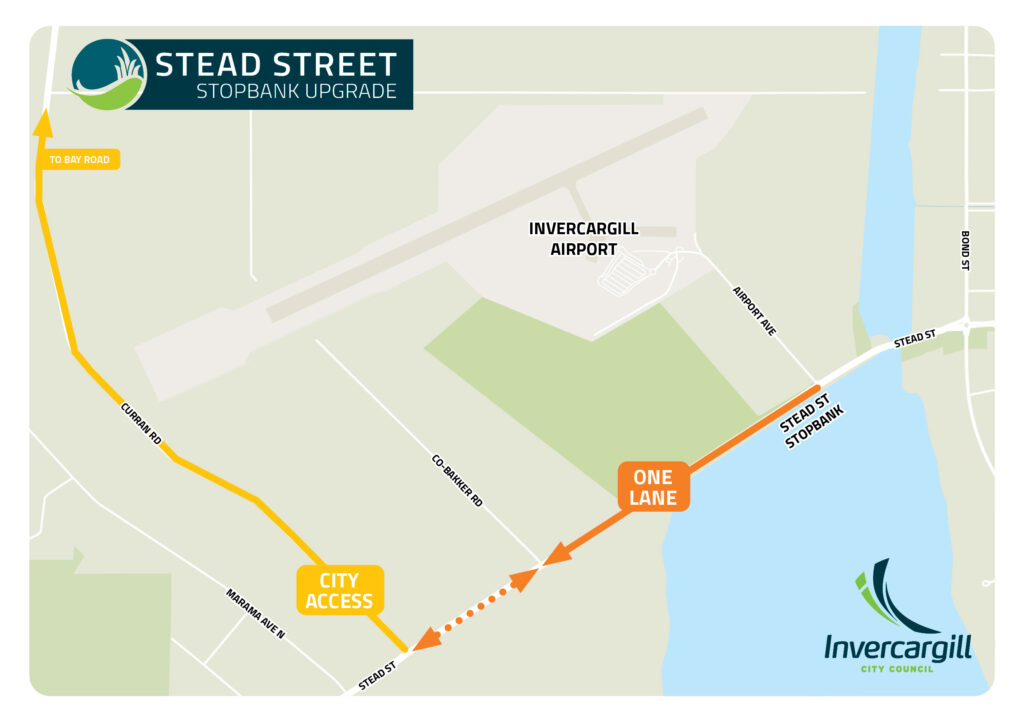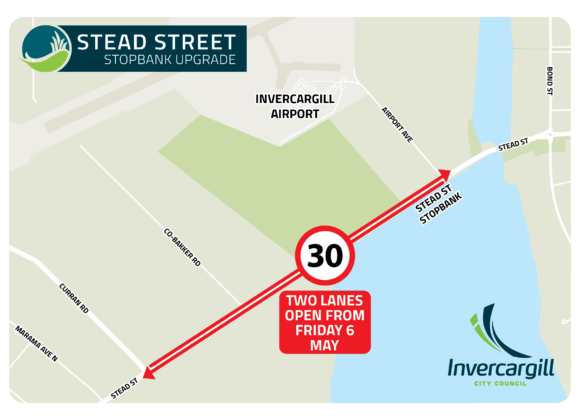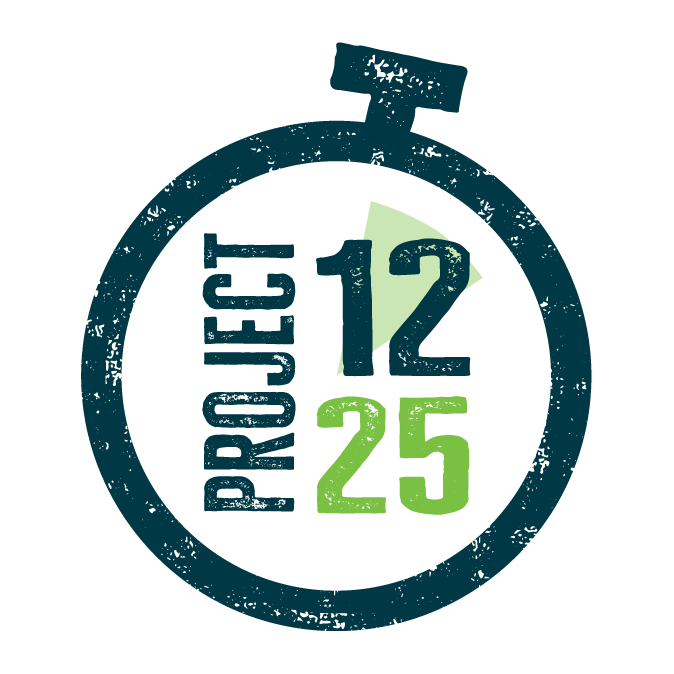📢 Stay up-to-date on the Stead Street Stopbank Upgrade |
|
|
Project overview
As part of a key climate resilience project in Southland, Invercargill City Council is upgrading the Stead St Stopbank, starting in 2021.
Waihōpai Invercargill and Southland are at high risk of flooding and we know that climate change effects will increase the likelihood of extreme weather events and their impacts.
The Stead St Stopbank will be reinforced with a sheet pile wall to ensure Waihōpai Invercargill, the Invercargill Airport and our critical infrastructure are protected from extreme weather events, sea level rise and climate change effects.
The top of the new floodwall will be higher and provide more robust defence than the existing earth embankment.
We will also be widening the current shared pedestrian and cycle pathway along the stopbank and widening and raising the height of the adjoining Cobbe Road stopbank.
The work is part of a wider focus on the region’s flood protection and river management schemes, with several ‘shovel-ready’ projects in Southland set to receive funding from Kānoa – Regional Economic Development and Investment Unit (previously known as Provincial Development Unit or PDU).
Environment Southland is also upgrading the Waihōpai River, Otepuni Stream and Kingswell Creek stop banks to complement this work to protect our city.
The work
From Monday 1 November, Stead Street will change to one lane (see below) in order to accommodate heavy machinery required for the works.
Work is expected to be complete in April 2022.
There will be some disruptions to the movement of traffic, cyclists and pedestrians while the work is under way. We will be implementing temporary traffic management plans to mitigate the increase in heavy transport vehicles and construction machinery. Temporary road, footpath and cycle track detours will also be necessary.
Traffic management
To mitigate the risk from construction and machinery, Stead St will temporarily become one lane, open only to westbound traffic travelling to Otatara, for the duration of the project. Traffic travelling eastbound from Otatara to Invercargill will be able to access the city via Bay Rd.

Access from the city to the airport is being prioritised, and the road will change to one lane after Airport Ave.
The shared pedestrian and cycle pathway will be temporarily relocated to the north side of Stead St for the project, and will allow for pedestrian and cyclist travel in both directions.
Stead St reopened to two-way traffic
Stead St has reopened to two-way, 30kmh traffic.
- Learn more: Stead St to open to two-way traffic [Media release].
Frequently Asked Questions
Why are you doing this?
Increased natural hazard risk associated with climate change, as well as the most recent overtopping event in 2016, means the top of the stopbanks on Stead St and Cobbe Rd need to be raised to prevent further overtopping and possible damage and flooding of Stead St (the Airport Straight) and wider areas.
We will also be widening the current shared pedestrian and cycle pathway along the stopbank.
How long is it going to take?
All work will be completed along Stead St and Cobbe Rd by the end of April 2022.
How will the works affect how I get to and from Otatara?
Stead St will become one-way only heading west out from town in to Otatara from November 2021, through to end of the works at the end of April 2022.
The speed limit will be 30km/hour.
A detour will be in place from Otatara into town, meaning people will take Otatara Rd or Curran Rd to access North Road/Dee Street via Bay Road. This detour will be in place for the entirety of work.
We’ve thought a lot about the best way to work on Stead St with the least interruption to residents and have considered all the impacts. Using a westward one-way route into Otatara means emergency services have direct access to Otatara, we can avoid congestion around Airport Ave, and Bay Rd is better suited to any queuing that may occur when people stop at the lights.
What about cyclists and pedestrians?
A shared pedestrian and cycle pathway will be temporarily relocated to the north side of Stead St for the project, and will allow for pedestrian and cyclist travel in both directions.

Why is Stead Street going to be one-way for so long?
To ensure consistency for all residents and visitors, keeping the one-way direction of traffic will ensure the works can continue uninterrupted and that there is no confusion or variation in driver expectations along the route.
It also avoids any stop-start conflict for traffic users at Stead St roundabout and Airport Ave that traffic lights and partial one-way might otherwise cause.
To complete this work, large cranes and machinery will need to be placed directly on the road, which means Stead St needs to become one lane. The shared pedestrian and cycle pathway, currently atop the stopbank, will be temporarily relocated to the north side of the road while these works are undertaken.
The width of the roadway along Stead St is approximately 11 metres, the crane is about 6 metres wide and requires at least another 1 metre to ensure it can be safely fenced off from the traffic. We have already widened the road to allow for one lane of traffic and a 1.5m shared pedestrian and cycleway. Unfortunately it is not possible to widen the road further because of the geometry and underlying ground conditions.
The shared pedestrian and cycle pathway is part of the Te Araroa trail, which is a significant national trail and under the Code of Practice for Temporary Traffic Management (CoPTTM) we must provide a safe alternative route.
How will the works affect how I get to and from the Airport?
Access to and from the Airport from Invercargill will be maintained as two-way from Stead St roundabout to the Airport. All access to Airport Ave from Stead St will be from the east end of Stead St only, meaning Otatara residents will have to take the detour around Bay Rd and through town.
Why not have a stop/go system on Stead St?
We have investigated traffic lights (or a stop/go system) to manage the traffic through Stead St, however, as the one lane section is more than 1km long it would cause significant queuing, impacting the entrance to the airport.
We used a traffic light system for recent work in this area, which showed us that vehicles queued back past Airport Ave and through to the Bond Street roundabout, causing delays in getting to the airport, and disruption to traffic flow in the wider network.
Why can’t the one-lane go in the other direction, or change throughout the day?
The traffic management plan is in place to ensure that traffic flow is maintained, access to the airport is not impacted and to ensure emergency services have the most direct access to Otatara as possible. To maintain this, ensure consistent traffic flow and to avoid confusion, the direction of the road needs to be westbound, from the city to Otatara.
It’s also important to note that Bay Road offers more traffic queuing space than North Rd, and there is limited space along Stead St and Airport Ave for vehicles, particularly large trucks, to be able to turn around if they drive down the road from the wrong side.
Will it cause congestion at the Bay Road intersection when coming into town?
The Bay Road intersection offers two righthand turning lanes into the City.
The traffic light system will automically adjust the intersection’s light timings to ensure optimal traffic flow.
You can learn more about traffic management and the SCATS traffic light system on the Waka Kotahi website.
What will happen if we don’t do these works?
The Stead St Stopbank is made of sand and silt, which means it is vulnerable to damage and overtopping events.
The stopbank will deteriorate rapidly in the event of frequent overtopping, storm surge and sea level rise, which is expected due to climate change. Stead Street will be inundated with water, leaving Bay Road as the only point route of access to and from the City from Otatara, and affecting the Invercargill Airport and other critical infrastructure in the area.
Will the pedestrian and cycle path be wider?
Yes, the new shared pedestrian and cycle path along the stopbank will be widened to 3 metres.
What’s happening with school buses to/from Otatara?
We’re working with the Ministry of Education to ensure school buses to and from Otatara operate as usual.
Why can’t a temporary new road be setup?
We have investigated the option of setting up a temporary road, however, critical infrastructure located along this proposed route means this is not possible.
Will the roads be open in the weekends?
No. The nature of the work requires the use of heavy machinery, which must be kept on site throughout the duration of the works.
We have investigated the potential of reopening the road during weekends, however, the added time and costs associated with moving the machinery and equipment in and out of the site makes this option untenable.
Why are we doing the works now?
The works are being majority-funded by the Ministry of Business, Innovation, and Employment (MBIE) through their Kānoa – Regional Economic Development & Investment Unit.
Funding for shovel-ready projects has key requirements on project milestones – if we delay the works we would risk forfeiting the funding.
What happens if COVID lockdown happens again?
As witnessed in 2020 and more recently in August 2021, any Level 4 lockdown will require all work to stop. Any such delays will require recalculation of final completion dates, but all attempts will be made to try and meet original timelines and targets where possible.
What do I do with my wheelie bins while the works are happening?
No Council infrastructure services will be interrupted by the proposed one-way traffic management along Stead St.
All utilities and services will follow the one-way traffic management and detours in place to provide continuity of Council services to residents and ratepayers, without interruption.
What are you doing?
Work by Fulton Hogan started at Cobbe Rd in August 2021, including raising the stopbank level and rock armouring of the estuary-side face of the stopbanks. This involves trucks and machinery
accessing Cobbe Rd from Stead St through to November 2021.
PowerNet Ltd is moving power services underground on the north side of Stead St and will complete the undergrounding works and connect new lines at the end of October 2021.
Stead St stopbank contractor HEB Construction will establish a one-way traffic flow along Stead St in November 2021. A temporary cycle and pedestrian pathway will be established on the north side of Stead St. This will enable sheet piling of the stopbank between November 2021 and the end of March 2022.
Following the sheet piling, the shared use path along the new stop bank will be replaced and landscaping installed between the path and Stead Street.
The sheet piling reinforcement will be installed at approximately 12m per day over the 1200m length of stopbank from the Waihopai River Bridge up to Cobbe Rd. This equates to 100 working days, or five months of work.
There is also other preliminary and subsequent work needed to enable the stopbank reinforcement, including power relocation and undergrounding, establishment of temporary pedestrian and cycleway connections along Stead St and the removal of overhead powerlines and power poles before the stopbank along Stead St can be reinforced.
Will the construction be noisy/dusty/affect my property?
All works will be undertaken during the daytime, and will have construction management practices in place to make sure dust and noise does not affect residential activities.
How much is it going to cost?
Council is investing $4.7 million in the project and additional funding of $10.8m is set to come from Kānoa – the Regional Economic Development and Investment Unit, as part of a wider focus on the region’s flood protection and river management schemes, with support for several ‘shovel-ready’ projects in Southland announced in 2020.
Documents and links
- Have questions? Download the Stead Street Stopbank Upgrade FAQ
- Live in Otatara? Download the Otatara residents community session flyer
- Media release: Stead St Stopbank Upgrade set to begin next month (5/10/2021)
- Keep updated: Sign-up to receive email updates
📢 Stay up-to-date on the Stead Street Stopbank Upgrade |
|
|



